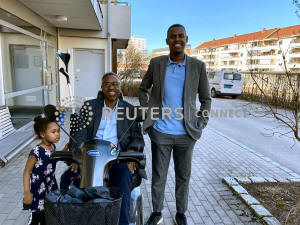COVID-19 takes unequal toll on immigrants in Nordic region
 Send a link to a friend
Send a link to a friend
 [April 24, 2020]
By Lena Masri [April 24, 2020]
By Lena Masri
(Reuters) - The first person in Sadad
Dakhare's two-bedroom apartment in Oslo, Norway, to show symptoms was
his 4-year-old niece. Next, his mother, his sister and he himself fell
ill. Then, about a week after his niece became sick, Dakhare heard his
76-year-old father coughing heavily.
He found his father lying in bed, gasping for air. "Just call an
ambulance," the father told Dakhare.
At an Oslo hospital, Dakhare's father tested positive for COVID-19 and
was treated for a few days before he was discharged to finish his
recovery at home.
The Dakhare family's story is a familiar one among Somalis in Norway and
other Nordic countries, where the pandemic is taking a disproportionate
toll on some immigrant groups. Governments in Sweden, Norway and Finland
are taking extra steps to try to slow the spread of the disease in these
communities.
Across Europe, little is known about who is affected by the virus
because governments are releasing limited demographic information about
the sick and those who die. But a Reuters examination of government data
in three Nordic countries where more details are available shows that
some immigrant groups are among those affected at higher rates than the
general populace.

"WORRYING" DISPARITY
In Norway, where 15% of residents were born abroad, 25% who had tested
positive for COVID-19 by April 19 were foreign-born. Somalis, with 425
confirmed cases, are the largest immigrant group testing positive,
accounting for 6% of all confirmed cases -- more than 10 times their
share of the population.
Somalis are the most overrepresented immigrant group among Sweden's
confirmed cases, as well. Their 283 positive tests account for about 5%
of the nearly 6,000 cases documented between March 13 and April 7.
That's seven times their share of the population. Iraqis, Syrians and
Turks also made up disproportionately large shares of positive cases.
In Finland's capital city of Helsinki, the mayor said it was "worrying"
that almost 200 Somalis had tested positive by mid-April. They accounted
for about 17% of positive cases -- 10 times their share of the city's
population.
More than 100,000 Somalia-born live in the three countries, mostly in
Sweden and Norway, one of the largest Somali diasporas in the world.
Many arrived as refugees of war in the 1990s, 2000s and 2010s. Several
factors place them more at risk of getting sick, public health officials
and researchers say.
VIRUS OUTPACES RESPONSE
It is common in all three countries for multiple generations of Somalis
to live, like the Dakhares do, in crowded apartments, making it easier
for the virus to spread from one family member to the next. They also
tend to work in high-contact jobs -- healthcare workers, drivers and
cleaners, for example -- with a higher risk for exposure.
Language barriers also are at play, and some have criticized governments
in Sweden and Norway for failing to move fast enough in communicating
about the virus to immigrant groups.
"By the time information translated to different languages was spread
sufficiently, the infection rate among minority groups was already very
high," said Linda Noor, a social anthropologist who is managing director
of Minotenk, a think tank focused on minority-related politics in
Norway. She said a lot of information in Norway was distributed through
national health authorities' websites that are unfamiliar to many people
in immigrant communities.
Public health officials in both Norway and Sweden pointed to COVID-19
information they published in multiple languages, including Somali, in
early to mid-March. But they acknowledged that they did not reach some
immigrants fast enough.

GETTING THE WORD OUT
"I think it is clear from the epidemiological situation, especially
looking at the high proportion of Somalis with COVID-19, that we did not
reach this group in time," said Hilde Kløvstad, department director at
the Norwegian Institute of Public Health.
Once the virus started to spread, officials realized they needed to be
more focused in their outreach, she said, adding that the spread of the
virus among immigrant communities is slowing.
[to top of second column]
|

Sadad Dakhare (R), his father Mohamed Dakhare Farah and niece Safa
Mohamed Hassan (L) who fell ill with the coronavirus disease
(COVID-19) but have now recovered pose in a photo taken in Oslo,
Norway April 23, 2020. Picture taken April 23, 2020. Samsam Muhammed
Dakhare/Handout via REUTERS

In Oslo, officials contacted leaders in immigrant communities, who
helped them get the word out via social media, word of mouth,
posters and online videos targeting Somalis, said Hanne Gjørtz, head
of communications for the city. Health alerts in Somali aired on the
radio, and text messages with translated information were sent to
Somali residents.
"We saw that this led to increased traffic on our websites," she
said.
"But we are constantly learning," she added. "It would definitely
have been an advantage to have videos and posters in place earlier
in this crisis. This has been and still is a crisis of great speed,
and it took some time for us to find the right ways to reach
different groups."
HITTING THE STREETS
In Rinkeby-Kista and Spånga-Tensta, two Stockholm boroughs where
immigrants and their children make up most of the population, rates
of infection are more than two times higher than in the city
overall. Trying to slow the spread of the virus in these areas,
where Somalis are the biggest minority group, the government is
offering temporary furnished rental apartments to at-risk-groups,
such as elderly people who live in multi-generational housing, said
Benjamin Dousa, chairman of the Rinkeby-Kista district council.
Government workers who speak a variety of languages, including
Somali, have hit the streets in immigrant-heavy neighborhoods --
near libraries, religious buildings, municipal offices, metro
stations and grocery stores -- to warn people about COVID-19, said
officials from government body Region Stockholm.
In a statement to Reuters, Region Stockholm said it could have been
faster in distributing multilingual information before the virus
began spreading disproportionately among immigrant groups.
"However, we are working in the middle of a situation which is
before unseen," the statement said. "Therefore, it is difficult to
be as fast as is needed and to foresee all needs."

The statement added that the infection rate is slowing in
Spånga-Tensta and Rinkeby-Kista.
"SITUATION DEMANDS TEAMWORK"
Helsinki is gearing up for similar outreach.
"The situation demands enhanced teamwork, continued development of
multilingual services and effective targeted communications," said
Mayor Jan Vapaavuori. "We have entered into discussions with the
Finnish Somali League about new measures to improve the situation."
Somalis themselves also are trying to spread the word about how to
stay safe.
Ayan Abdulle posted an informational video on Facebook, but she
found she wasn't reaching the people who needed the information
most.
Abdulle, 29, who was born in Somalia and came to Norway at age 9,
heads a non-governmental organization in the city of Bergen called
Arawelo, which usually focuses on helping young immigrants apply for
jobs and find friends. After the coronavirus outbreak, Abdulle
started to focus on the elderly as well, helping them with grocery
shopping. When she spoke with elderly Somali women out shopping last
month, she learned they were not getting enough information about
the coronavirus because they weren't using social media and not all
of them understood Norwegian.
"In Somali culture, most information is spread by word of mouth,"
Abdulle said. "Now we are going from door to door and hanging
posters informing people about the symptoms and how dangerous the
disease can be."
(Reporting by Lena Masri in London. Editing by Janet Roberts and
Ryan McNeill.)
[© 2020 Thomson Reuters. All rights
reserved.] Copyright 2020 Reuters. All rights reserved. This material may not be published,
broadcast, rewritten or redistributed.
Thompson Reuters is solely responsible for this content. |